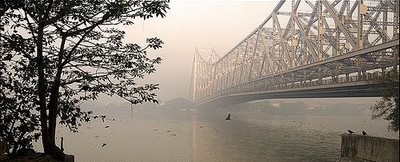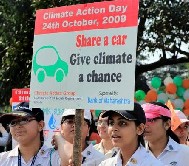Archive
Food for Thought – The Hunger Merchants
Gandhiji once said, “There’s enough for everyone’s need, but not enough for everyone’s greed”. The rapaciousness displayed by unprincipled businesses in sub prime lending and other financial concoctions have already resulted in an economic meltdown. Its brand new avatar to profit from helplessness of mankind is likely to be rewarded the same way. We can only hope they would realize their folly and amend ways.
An excellent report on global land grabs can be found here: Link
Planetwatch series – Ominous Convergence
Another crisis, no less damaging, is gradually looming on the horizon – oil crisis. Recent reports indicate that world oil reserve estimates are grossly inflated. Hubbert’s peak, long rubbished as fantasy, after all might have had a grain of truth. However, oil hungry nations chose to underplay the hypothesis to keep prices at bay. Crude oil reserves are depleting. Cost of exploration and production has increased. The age of low hanging fruits, the easily accessible oil deposits is over. Today, new crude discoveries have to be extracted from remote, inhospitable terrain or leached out of tar sands. Stringent environmental and safety regulations have also increased the cost of production, refining and distribution. Oil prices have been steadily climbing and hover around $80.00 today. Countries forewarned of an impending crisis are scouting the globe to strike oil deals. Hedge funds and venture capitalists are moving in to exploit the scarcity. A recent web article (Link) cited knowledge of impending oil crisis as the logic behind Warren Buffett’s acquisition of an US Railway company. Right now the hype is focused on climate change and Copenhagen negotiations. It won’t be long before skyrocketing oil prices push climate change concerns to the background.
Human civilization across the globe, in cities and villages alike, is heavily dependent on crude oil and fossil fuels. Declining availability will force oil producing nations to drastically cut down production in order to safeguard themselves. Oil prices would soar, purchasing power of nations would plummet and global economy would nosedive. Credit will vanish. Countries will go bankrupt unable to raise money through taxes.
Imagine the sledgehammer power with which world would be battered when these mutually reinforcing forces, climate change, oil crisis and economic meltdown, converge. It would tremendously strain the dwindling natural resources and tapering oil reserves. Agriculture and food production would decline. Instead of the calamitous, earth shattering forces shown in the movie 2012, it would be hunger, epidemics and natural disasters that decimate humanity. Consequences for a relatively poor and overpopulated country like India are indescribable. With politicians and bureaucrats are still bickering over emission cuts, it is virtually impossible to avert disaster.
When societies undergo intense stress, the survival struggle could rapidly escalate into war. Many countries have large nuclear arsenal under their disposal presumably as a deterrent. It is not difficult to envisage a situation where unscrupulous politicians or military decide to use nuclear weapons to resolve differences.
End of the world have been predicted many times over in the course of human history. But now, more than ever, circumstances and catalysts exist which could realize our worst fears. My fervent hope is that when world leaders meet to negotiate, the welfare of humanity would be their prime concern rather than short term political gain.
Kolkata – Edging towards a climate change disaster?

So, when I came across the WWF report, Mega-Stress for Mega-Cities, featuring climate change consequences for Kolkata, it immediately caught my attention. The report analyzed 11 major Asian cities which are in the “front-line of climate change impacts”. Kolkata is ranked third on the overall vulnerability assessment. Situated at the estuary of Hoogly River on the Bay of Bengal, Kolkata, with more than 15 million people, is one of the most densely populated coastal cities of India. Being a low lying area, the city is extremely susceptible to sea level rise and storm surges which could inundate large stretches of it. It is also at risk of salt water incursion due to sea level rise and ground subsidence. Over-exploitation of ground water in and around Kolkata combined with sea water incursion has rendered subsurface ground water saline. Altered precipitation patterns and intense rainfall are leading to water run-off. Ground water is not enriched since rainwater no longer seeps underground. Alternate spells of drought and floods are predicted to lead to water scarcity and food insecurity. According to the report, the city also has a low adaptive capability to endure the impact of climate change. Sundarbans, the salt resistant mangrove forest and home to the Royal Bengal Tiger acts as a flood barrier protecting the inhabitants of Kolkata from cyclones and storm fronts. However, this UNESCO world heritage site is also under threat from sea level rise, subsidence, erosion, cyclones and human activity.
 So, does all this doomsday prediction likely to make Bengali an endangered species. Gosh! No. They are determined to thrive and proliferate. Awareness of vulnerability of the city is percolating into the consciousness of Kolkatans. Recently, school children from Kolkata participated in the international day of climate action organized by “350“, the international campaign to unite the world in finding solutions to climate change crisis(350 stands for 350 parts per million, the safe upper level of atmospheric CO2).
So, does all this doomsday prediction likely to make Bengali an endangered species. Gosh! No. They are determined to thrive and proliferate. Awareness of vulnerability of the city is percolating into the consciousness of Kolkatans. Recently, school children from Kolkata participated in the international day of climate action organized by “350“, the international campaign to unite the world in finding solutions to climate change crisis(350 stands for 350 parts per million, the safe upper level of atmospheric CO2).
Planetwatch series – Are climate change theories overestimated

 The Plastiki is a catamaran made of reclaimed plastic bottles and recycled material getting ready to set sail from San Fransisco, USA on its way Sydney, Australia. En Route the vessel shall visit 12 ecologically susceptible locations, including the Great Pacific Garbage Patch. On board shall be a team of scientists and artists led by David de Rothschild, a prominent ecologist. The purpose of the journey is to bring to attention the enormous amount of garbage being disposed in the sea.
The Plastiki is a catamaran made of reclaimed plastic bottles and recycled material getting ready to set sail from San Fransisco, USA on its way Sydney, Australia. En Route the vessel shall visit 12 ecologically susceptible locations, including the Great Pacific Garbage Patch. On board shall be a team of scientists and artists led by David de Rothschild, a prominent ecologist. The purpose of the journey is to bring to attention the enormous amount of garbage being disposed in the sea.
Planetwatch series – Green aviation fuels et al.

Fly Guilt free
Airline industry is poised to adopt green fuels as an alternative to traditional aviation jet fuel. Major airlines like Qatar airways and Virgin Atlantic have already conducted test flights using engines running on sustainable bio-fuel or GTL, a 50-50 blend of natural gas and conventional fuel. Airlines expect substantial reduction in carbon footprint by employment of green fuel alternatives.
Read the full article here: Link
Retreat of Antarctic ice caps and glaciers have exposed large tracts of open water which has been rapidly colonized by carbon-absorbing phytoplankton. As they die these phytoplankton sinks to the sea bed locking away the absorbed carbon for millennia. This ingenious carbon capture and sequestration technique devised by Mother Nature helps to mitigate the effects of climate change, albeit marginally.
Read the full article here: Link
Recently Maldives made headlines when it held a cabinet meeting underwater to illustrate the plight of the nation due to climate change effetcs. Maldives, with an average ground level a mere 1.5 meters above mean sea level is the country most threatened by sea level rise. In an initiative to demonstrate the country’s commitment to renewable energy and reduction of green house gas emissions, Maldives is planning to set up a 75 MW wind farm which will power its capital and the tourist resorts.
Planetwatch series – Huarango forests of Peru

Huarango forest
Huarango (Prosopis pallida) is the ultimate survivor. This hardwood tree has survived in the arid and frigid Atacama – Sechura deserts of Peru for over a millennium. Veteran trees since the time of Spanish conquistadors still exist in isolated pockets. The trees are critical to the ecosystem. They nourish soil, capture moisture from the sea fog, prevent desertification and soil erosion, increases biodiversity of the region and provide food and timber to the villagers. However, centuries of deforestation have depleted Huarango woodlands to 1% of its original size. Although conservation efforts are underway, cutting down of Huarango for firewood continues unabated.
Here again the immediate business of survival and profit have taken precedence over preservation. Someday, jolted out of our complacence we would blink and see that the only jungles left behind are concrete ones.
Inspired by article in NY Times – Link
Planetwatch series – Ice Man of Ladakh
Ladakh in northern India, is a cold desert. It is also a major tourist destination. People of Ladakh depend on glacial melt water for irrigation and domestic use. However, glaciers have been receding at an alarming pace in recent years leading to severe water shortages. It is in this context that Chewang Norphel’s initiative gains significance. In a pioneering effort, he has made embankments on mountainsides to collect water which freezes during the winter months into an artificial glacier. During summer the ice melts providing water to nearby villages. It is a venture astounding in its simplicity and practicality, well adapted to the necessities of the region. Such conservation methods are infinitely more preferable to digging bore wells which deplete ground water resources.
Ladakh have been experiencing higher average temperatures, unusual rainfall patterns, reduced snow cover and other associated fallouts apart from deterioration of glaciers in the past few years. Despite experiencing these problems firsthand and understanding the antecedent causes, attitude and behaviour have remained unchanged. It is business as usual. Vehicular pollution is still relatively high and littering continues to be problem. It looks like we find it easy to relegate long term effects of climate change to the background in favour of the immediate occupation of survival and comfort.
The Copenhagen summit to frame legally binding treaties to address climate change issues have already hit a road block. US, the world’s biggest cumulative greenhouse gas emitter has declined to submit to emission cut targets and timetables. Developing nations are not willing to jeopardize their economic agenda by subscribing to restrictive environmental regulations. When the world at large is engaged in acrimonious debate over such a critical issue, it is a relief to find that a few have chosen to act instead. My heart goes out to Chewang Norphel.
Inspired by: Op-Ed article in The Hindu by Meena Menon, 7-Nov-09
Quo Vadis
I am surprised that climate change issue is still debatable. Over the past few years, we have witnessed many effects of climate change first hand. This year has been one of the hottest here at Gurgaon, with mercury hovering at 46 °C during summer. It is the end of September and still the average temperature is around 38 °C. There has been a huge shortfall of rain across the country. Many states have been declared drought hit. Open any newspaper or turn on the TV and we are overwhlemed with news of diasters across the globe, many of which are related to climate change.
Until recently, we shrugged off climate change as mere scientific speculation. Temperature rise, rise in sea levels, sea acidification, melting of glaciers – all these were considered remote events, no way impacting our lives. Not anymore. Today, we are experiencing the effects closer to home, jolting us out of our complacency.
In “An Inconvenient Truth“, Al Gore compared our attitute to that of a frog kept in water which is being gradually brought to boil. If the frog is thrown in hot water, it would immediately jump out. However, if the temperature rises gradually, the frog does not realize the danger until it is too late. A large proportion of us are still under a similar spell, lulled by the gradual rise in temperature. In a recent New York Times article, Paul Krugman called climate change scientists Cassandras of climate – “gifted with the ability to prophesy future disasters, but cursed with the inability to get anyone to believe them”. Even though scientists have warned us of the clear and present danger, we continue to vacillate between denial and affirmation. The polemic of climate change detractors have also added to the confusion. But, probably, it is less a matter of confusion than consious denial because the truth is too “inconvenient”, as Al Gore put it.
We cannot shutdown our refineries or power plants tomorrow. Neither can we stop driving to work or stop running the air conditioners. Currently we depend on fossil fuels, be it coal, oil or gas for our energy needs. But we cannot survive unless we drastically reduce pollution, cut back energy consuption and embrace green energy. This would mean adopting technologies which are nascent and more expensive. It would also mean changing our lifestyle, giving up the SUV’s, installing solar heaters, harvesting rain water and conserving energy. Without sufficient appreciation of danger by all, no one would be willing to make such sacrifices, fearing themselves open to exploitation.
It would need universal awareness, cooperation, commitment and joint affirmative action to save the planet. Being the purportedly rational animals, can we achieve such a consensus? Otherwise, our nemesis would not be asteriods or aliens, but ourselves. We have nowhere to go from here, the planet is our only home. It is time for us to define our future on planet earth. It is time to choose our path. Quo Vadis?


